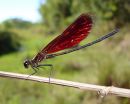(Press-News.org) LAS VEGAS - A team of orthopedic surgeons from the Perelman School of Medicine at the University of Pennsylvania has found that modern technology for healing distal femur fractures is as safe and effective as its more established alternative, without a potential shortfall of the older approach. The team found that when done correctly, there are no significant differences between the two approaches - "locked plating" and "non-locked plating" - in terms of healing rates, need for corrective surgery, or hardware failure. The findings are being presented on Thursday, March 26, 2015, at the American Academy of Orthopaedic Surgeons Annual Meeting in Las Vegas.
The team examined medical records of 95 patients who underwent surgery to repair distal femoral fractures. Though relatively uncommon in the general population, an increase in the number of these fractures is expected as the population ages. For 80 percent of the patients studied, the fracture healed within 3.5 months of surgery, while 20 percent needed corrective surgery. The researchers found that patients whose surgeons used locked plating - which historically required a second revision surgery roughly 40 percent of the time - had no more setbacks than patients whose providers used non-locked plating.
The two methods differ by virtue of their use of locking and non-locking screws, respectively, to attach metal plates to fractured bone in order to provide stability and promote healing. While locked plating virtually eliminates the possibility of the plate moving, it has been associated with pronounced stiffness and rigidity around the healing bone, which can prevent the broken bone from healing.
"Plates used in distal femur surgery come in various sizes, and have as many as 16 to 20 apertures, or screw holes," explained the study's senior author Samir Mehta, MD, chief of the division of Orthopaedic Trauma at the Perelman School of Medicine at the University of Pennsylvania. "In the early days of locked plating, some surgeons used screws in every one of these apertures, which we think lead to stiffness, rigidity and pain for patients. Today, surgeons are more judicious, using far fewer screws and picking and choosing which holes to insert the screws in based on factors in the case at hand. This improved decision-making on the part of surgeons is what we believe has resulted in the significant decrease in technical problems associated with locked plating."
According to the researchers, the one factor that had a significant impact on fracture healing was if the fracture was open. Additionally, two factors increased the risk of poor healing for the participant population, but did not reach statistical significance: diabetes and non-weight bearing status post-operatively. The latter finding points the way toward early weight-bearing by patients, typically within a few days of surgery, rather than remaining in bed.
"As surgeons become more adept at application of both established and developing implant technologies, outcomes will continue to improve," said lead investigator Ryan M. Taylor, MD, a fifth-year resident in the department of Orthopaedic Surgery at the Perelman School of Medicine at the University of Pennsylvania. "However, we must remain cognizant of patient specific variables such as age, weight, and pre-existing comorbidities, which can affect overall care strategies and management."
INFORMATION:
Other Penn co-authors are Andrew H. Milby, MD, Jaimo Ahn, MD, PhD, and Derek J. Donegan, MD. Other co-authors are F. Omoleye Roberts, MD, of Northwestern University and Mara L. Schenker, MD, of the University of Washington, Seattle.
Penn Medicine is one of the world's leading academic medical centers, dedicated to the related missions of medical education, biomedical research, and excellence in patient care. Penn Medicine consists of the Raymond and Ruth Perelman School of Medicine at the University of Pennsylvania (founded in 1765 as the nation's first medical school) and the University of Pennsylvania Health System, which together form a $4.9 billion enterprise.
The Perelman School of Medicine has been ranked among the top five medical schools in the United States for the past 17 years, according to U.S. News & World Report's survey of research-oriented medical schools. The School is consistently among the nation's top recipients of funding from the National Institutes of Health, with $409 million awarded in the 2014 fiscal year.
The University of Pennsylvania Health System's patient care facilities include: The Hospital of the University of Pennsylvania -- recognized as one of the nation's top "Honor Roll" hospitals by U.S. News & World Report; Penn Presbyterian Medical Center; Chester County Hospital; Penn Wissahickon Hospice; and Pennsylvania Hospital -- the nation's first hospital, founded in 1751. Additional affiliated inpatient care facilities and services throughout the Philadelphia region include Chestnut Hill Hospital and Good Shepherd Penn Partners, a partnership between Good Shepherd Rehabilitation Network and Penn Medicine.
Penn Medicine is committed to improving lives and health through a variety of community-based programs and activities. In fiscal year 2014, Penn Medicine provided $771 million to benefit our community.
The number of total hip replacements (THRs) nearly doubled among middle-aged patients between 2002-2011, primarily due to the expansion of the middle-aged population in the U.S., according to a new study presented today at the 2015 Annual Meeting of the American Academy of Orthopaedic Surgeons (AAOS). Continued growth in utilization of hip replacement surgery in patients age 45 to 64, an increase in revision surgeries for this population as they age, and a nearly 30 percent decline in the number of surgeons who perform THR, could have significant implications for future ...
A new study presented today at the 2015 Annual Meeting of the American Academy of Orthopaedic Surgeons (AAOS) found that black and Hispanic patients were 62 and 50 percent, respectively, more likely to be readmitted to the hospital within 30 days after total joint replacement (TJR) surgery compared to white patients. In addition, Medicaid patients were 40 percent more likely to be readmitted to the hospital than patients with private insurance.
Disparities in the provision of health care services have long been documented, including that black patients utilize hip and ...
While women may have their first total joint replacement (TJR) at an older age, they are less likely to have complications related to their surgery or require revision surgery, according to a new study presented today at the 2015 Annual Meeting of the American Academy of Orthopaedic Surgeons (AAOS). The findings contradict the theory that TJR is underutilized in female patients because they have worse outcomes then men.
Total hip (THR) and total knee replacement (TKR) are common surgical treatments for end-stage arthritis, which causes ongoing pain, limited function and ...
An injection of a patient's bone marrow stem cells during rotator cuff surgery significantly improved healing and tendon durability, according to a study presented today at the 2015 Annual Meeting of the American Academy of Orthopaedic Surgeons (AAOS).
Each year in the U.S., more than 2 million people have rotator cuff surgery to re-attach their shoulder tendon to the head of the humerus (upper arm bone). Rotator cuff tears can occur during a fall or when lifting an extremely heavy object; however, most tears are the result of aging and overuse.
The French study, of ...
Nasal drops of harmless bacteria can inhibit a related bug that sometimes causes meningococcal disease, according to new findings published online in Clinical Infectious Diseases. The study--conducted among college students, a group at higher risk for this often serious illness--suggests a new approach that could help suppress outbreaks of the disease, if supported by future research.
Meningococcal disease is caused by Neisseria meningitidis, which can infect the lining of the brain and the spinal cord, causing meningitis. Strains of the bacteria can also cause serious ...
A decade on from the Northern Nigeria polio vaccination boycott and its global costs to the polio eradication initiative, a new report examines global issues affecting vaccine confidence and hesitation since the new millennium.
The State of Vaccine Confidence Report from researchers at the London School of Hygiene & Tropical Medicine (published 26 March) analyses some of the vaccine confidence issues that have occurred over the past decade with a range of vaccines, reports on strategies that have had positive impacts on engaging populations and building trust and confidence, ...
New research from The University of Manchester out today (26 March) concludes that there is limited evidence to show that xylitol is effective in preventing dental cavities in children and adults.
Xylitol is a natural sweetener that is widely promoted globally, and can be found in wide range of everyday products including sugar-free chewing gum, toothpaste, gels, lozenges and sweets.
Xylitol is a popular sugar substitute in sweets and it is already known to cause less damage to teeth than sugar. It has also been suggested that the addition of xylitol to products may ...
ROCHESTER, Minn. -- As employees and employers face higher health care costs, work site wellness are becoming increasingly more important to help control the costs of health care and encourage healthy lifestyle behaviors among the workforce, a Mayo Clinic study says.
Research published this month in the Journal of Occupational and Environmental Medicine shows that members of Mayo Clinic's employee wellness center, the Dan Abraham Healthy Living Center (DAHLC), who regularly participated in wellness activities, experienced significant weight loss and health care costs ...
Before a male damselfly hot-headedly enters into a duel of aerial sparring, it first works out its strategy. It gives its opponent's wings a once-over to assess its strength, knowing that more transparent wings and larger red spots generally show a stronger rival. Those who then decide to engage in long fights either try to wear their opponent down, or dazzle them with brilliant aerial moves that are too hard to follow. These damselfly war game strategies are set out in a study published in Springer's journal The Science of Nature - Naturwissenschaften. Two research groups ...
By combining observations from the Japan-led Suzaku X-ray satellite and the European Space Agency's infrared Herschel Space Observatory, scientists have connected a fierce "wind" produced near a galaxy's monster black hole to an outward torrent of cold gas a thousand light-years across. The finding validates a long-suspected feedback mechanism enabling a supermassive black hole to influence the evolution of its host galaxy.
"This is the first study directly connecting a galaxy's actively 'feeding' black hole to features found at much larger physical scales," said lead ...

